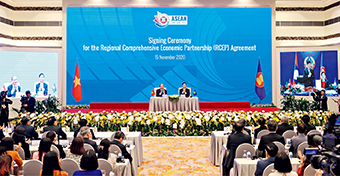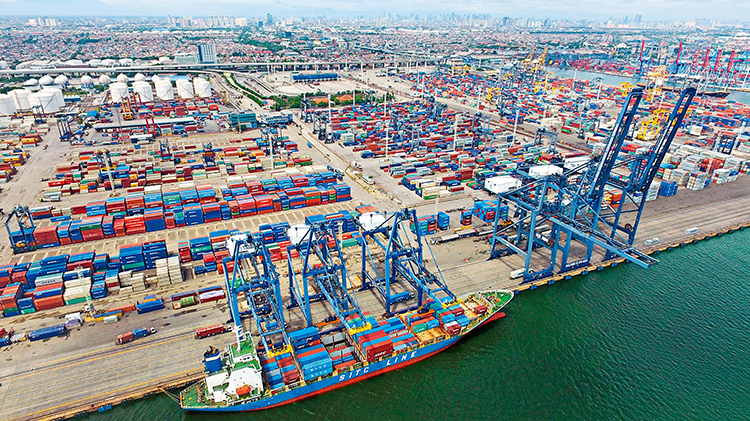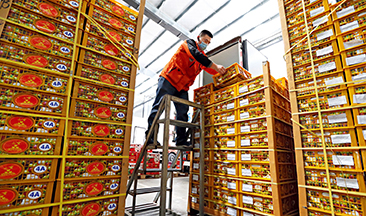
A port in Bangkok,Thailand.(MONGKOL CHUEWONG/GETTY CREATIVE)
After nearly eight years of negotiation,the Regional Comprehensive Economic Partnership(RCEP)has finally been signed by its 15 participating countries: the 10 ASEAN member states and five regional partners(China,Japan,South Korea,Australia,and New Zealand).This is a comprehensive free trade agreement that covers the largest population in the world,features the most diversified member structure,and offers the greatest potential for development.
The hard-won trade pact aims to form a unified system of rules for the region,reduce costs of business operation,and minimize the risk of uncertainty in business to lift East Asian countries to a new phase of regional cooperation and inject strong momentum into economic recovery and development of the Asia-Pacific region and the world.
What impact will the RCEP signing exert on regional cooperation and business development?Will it create opportunities or challenges?In this issue,China Report ASEAN invited scholars from China and ASEAN countries to share perspectives on these questions.
A NEEDED BOOST FOR GLOBAL TRADE
RCEP will drive supply chain upgrades in the Asia-Pacific region
By Zhou Mi

The virtual signing ceremony of the Regional Comprehensive Economic Partnership(RCEP)agreement in Hanoi,Vietnam,on November 15,2020.(XINHUA/VNA)
The latest reading of the WTO’s Goods Trade Barometer,a real-time gauge of trends in global trade,showed that global merchandise trade took a historic fall in the second quarter of 2020.Additional indicators point to partial upticks in world trade and output in the third quarter,but the strength of any recovery remains highly uncertain.The current reading of 84.5 is 15.5 points below the baseline value of 100 for the index and down 18.6 points year-on-year,the worst on record since 2007.
The outbreak of COVID-19 has inflicted severe damage on the global economy.A key indicator of the health of the global economy,the development of international trade often preludes economic development for an extended period.
The signing of the Regional Comprehensive Economic Partnership(RCEP)agreement will provide a new stimulus for global trade to recover from the pandemic by promoting the structural upgrading of the supply chain in the Asia-Pacific region and fostering better conditions for all sides to achieve sustainable economic and trade recovery.
Coordinated Promotion
RCEP member countries vary in terms of economic development stage,market competition mode,legal system,and other areas.Without any mature template for direct reference and guidebook,this unprecedented mega-intergovernmental economic and trade agreement is the direct fruit of concerted efforts by participating governments.
In 2011,the ASEAN Economic Ministers’ Meeting released a draft of RCEP.In 2013,ASEAN launched formal RCEP negotiations.Since then,four leadership meetings,nearly 20 ministerial meetings,and more than 30 rounds of formal negotiations have been held.Over the last seven years,participating governments have played a lead role in facilitating completion of negotiations.
As early as August 2014,the joint communiqué of the second RCEP ministerial meeting called for conclusion of negotiations and a final agreement by 2015.However,certain negotiations proved particularly intricate,and its massive scope eventually slowed the process.The first leaders’ meeting in 2017 broke through much of the bottleneck in negotiations by providing effective support for resolution of inter-agency obstacles and formulation of agreements acceptable to all parties.
Reshuffling of governments in Australia,Japan,New Zealand and other countries over the last seven years never compromised the goal of signing of the agreement.
Market Forces
The conclusion of the RCEP agreement depends on market forces,which have provided a stable fuel for continuation of the process.
The largest free trade agreement with the largest geographical and population coverage in the world,the RCEP involves ASEAN member states,China,Japan,South Korea,Australia and New Zealand,countries which have maintained close economic and trade relations for some time.
In recent years,regional economies have actively signed bilateral free trade agreements(FTAs)to solve sluggish market openings after disruption of multilateral negotiations.The patchwork approach resulted in a vast network of overlapping and intertwined FTAs and a “spaghetti bowl effect”that has increased the cost for enterprises to engage in economic and trade cooperation.
Many RCEP members supplanted multilateral WTO negotiations with bilateral FTAs to improve conditions for trade with relevant countries.The signing of the RCEP agreement will greatly minimize the differences between individual FTAs and create better conditions for low-cost flow and allocation of goods,services,capital,personnel,and technology among participating countries.
Broad Significance
The RCEP agreement is clearly highly significant.For economic and trade agreements to produce big results,they must be open and inclusive in breadth and depth.
The signing was a relief for negotiators from the 15 participating countries.Years of hard work finally paid off,and the news immediately boosted the confidence of international traders and investors looking for concrete action in opposition to trade protectionism.
The WTO officially commenced on January 1,1995 under the Marrakesh Agreement and remains the world’s largest platform for economic and trade cooperation with 164 full members and 25 observers.The original intention for establishment of the platform was to continuously formulate new rules based on global economic,trade,and technological development.However,the latest negotiations,the Doha Round,launched just after the turn of the century,have been continuously delayed and have not yet resulted in any new agreement.As a result,existing economic and trade rules,especially the content and coverage of commitments on opening certain sectors,have become inadequate for the needs of ongoing international economic and trade activities.
Because of the negotiating modality of “Single Undertaking”(nothing is agreed until everything is agreed),offers made by various parties in the Doha Round have not been translated into realistic commitments to openness for more than a decade.
In contrast to WTO modality,the RCEP has continuously adjusted and improved during the seven-year negotiation process with fluid updates and improvements to existing multilateral trade and economic rules to meet the development needs of all parties considering their current economic and trade activities and global trends.
More importantly,the RCEP creates better conditions for optimization and restructuring of industrial and supply chains in the Asia-Pacific region.Shutdowns to fight the pandemic highly disrupted personnel exchange and stagnated logistics.Both supply and demand sides of the market received massive pressure to adjust.To secure a guaranteed supply of goods and services,the market has often looked to regions where the pandemic is under control.East Asia has excelled at balancing pandemic containment and economic recovery.
Signing of the agreement will stabilize supply in East Asia to better meet the needs of the markets of RCEP members and optimize the capabilities of these countries.Through market competition and collaboration,stronger and more effective industrial and supply chains will be forged around the markets of RCEP members.
Like NAFTA and other regional trade agreements,the rules of origin(ROO)in the RCEP agreement specify the ratio of value added to products which can enjoy preferential tariff treatment.The rules will guide and adjust the market behavior of enterprises to create more industrial chain links that enable value-adding within the region to offset some trade transfer.
However,the RCEP is not simply about trade transfer.More importantly,coordination and reorganization of the industrial chain will optimize allocation of resources and kindle innovation.
The Chinese government has persisted in its process of opening-up.It has encouraged all kinds of innovative activities and developed new types of economic systems such as the digital economy.The development momentum created by such innovative practices can quickly spread through the large market of the RCEP.All parties in the industrial chain will share the benefits of development through cooperation.RCEP members,including China,are expected to gain new development benefits in the process of industrial chain restructuring.
Persistent Improvement
To be most effective,the RCEP should be fully understood and applied by relevant parties.Participating governments at all levels,relevant organizations,enterprises,and individuals all play a role.
Enterprises should understand both the rights and opportunities of economic and trade cooperation the agreement facilitates,but also be aware of the obligations and challenges the agreement could bring.
As with any economic or trade agreement,the RCEP will need to be constantly adjusted,updated,and improved.By leveraging guarantees from relevant economic and trade mechanisms,all RCEP members should monitor their implementation and make necessary adjustments.Participating parties are expected to actively provide feedback and share relevant information to help form an effective updating mechanism.
About the author
Zhou Mi is deputy director of the Institute of Americas and Oceania of the Chinese Academy of International Trade and Economic Cooperation.
A HISTORIC DEAL
RCEP will boost ASEAN's economy
By Yao Weiqun
The Regional Comprehensive Economic Partnership(RCEP)is a comprehensive,high-quality and mutually beneficial free trade pact involving market access commitments in sectors including trade in goods,trade in services,and investment.It will eliminate as much as 90 percent of tariffs on trade in goods between signatory nations,and its commitments on free trade in services are significantly higher than the former ASEAN-plus-one free trade agreements(FTAs).In terms of investment and market access,RCEP uses a negative list management mode and introduces rules to facilitate trade,intellectual property protection,e-commerce,competition policies,government procurements,and other operations.
RCEP was first proposed by ASEAN in 2012,at which time six dialogue partners,namely,China,Japan,South Korea,Australia,New Zealand,and India,were invited to participate.India eventually decided against signing the RCEP pact,but the other 15 negotiating countries reached the consensus and signed the agreement.The pact aims to reduce tariffs,remove non-tariff barriers,improve the investment environment,expand trade in services,strengthen intellectual property protection,and establish rational competition policies so as to build a more integrated Asia-Pacific market.The 15 participating countries of RCEP differ significantly in terms of level of economic development.They include developed industrialized countries,emerging industrialized economies,emerging market countries,developing countries,and least developed countries.Of them,the developing countries and least developed countries are primarily ASEAN member states.
The RCEP signing marked the formation of a big integrated market covering 30 percent of the world's population and about 30 percent of global GDP.A new milestone in the economic integration of the Asia-Pacific region,it will acutely promote trade and investment liberalization and multilateralism,strengthen international cooperation on epidemic prevention and control,safeguard regional manufacturing networks,stabilize the regional supply chain,enhance the resilience of the global value chain,and boost economic recovery and growth in the Asia-Pacific region.
Lim Jock Hoi,secretary-general of ASEAN,called the RCEP signing historic.He said that a multilateral trade agreement of this magnitude in the midst of haunting global and regional challenges testified to ASEAN's abilities,and stressed that determining whether ASEAN countries optimally enjoy outcomes of the pact is the most important index to assess RCEP.
In terms of structure,RCEP adopts a nested structural system based on five ASEAN+1 FTAs,all centered around ASEAN.Such design not only integrates existing commitments and rules,but also expands and enhances coverage of the pact.This model highlights ASEAN's significant role in economic integration in the Asia-Pacific region and treats different member countries through a nested rule system.Respective FTAs signed by ASEAN with China,Japan,South Korea,Australia,and New Zealand form the basis of cooperation through a binding guarantee enabling ASEAN to standardize economic and trade relations with those five members under the framework of RCEP,thus stabilizing the regional market.From the perspective of international relations,RCEP is more than just a regional trade and investment arrangement.More importantly,it is a basic framework for ASEAN to develop strategic partnerships with the other five member countries.
Customs data has shown that RCEP's measures for liberalizing trade in goods through reduced tariffs and removal of non-tariff barriers will have a massive trade stimulus effect for ASEAN and the other five member countries.The deal will reduce cross-border trade costs through enhanced trade facilitation.Indonesian Minister of Trade Agus Suparmanto opined that RCEP solidifies ASEAN's central role in the global supply chain.Experts predict that in the first five years of the RCEP,Indonesia's cargo exports to other member countries will increase by 8 to 11 percent,and the spillover effect will stimulate Indonesia's total exports to grow by 7.2 percent.Philippine Trade Secretary Ramon Lopez noted that RCEP participating countries account for more than 50 percent of the Philippines’ export market,and the landmark agreement,which has improved levels of market access among signatory countries,offers wider market opportunities for major Philippine exports such as agricultural products,automobile parts,clothes,and specialty products like canned tuna and preserved fruits.Vietnamese media predicted the RCEP to help expand the export market of Vietnam's telecom products,IT products,textiles,shoes,and agricultural products.Chinese experts estimate significant cutting of tariffs and removal of non-tariff barriers to boost the respective trade volumes of Indonesia,Malaysia,the Philippines,Singapore,Thailand,and Vietnam by 3.22 percent,2.48 percent,0.84 percent,0.35 percent,3.84 percent,and 3.74 percent.China also expects smaller ASEAN economies such as Brunei,Cambodia,Laos,and Myanmar to increase their foreign trade because of the RCEP.
According to the “new-new”trade theory,internationalization of enterprises can be achieved either through “selling products where they are produced”or through “producing products where they are sold”by direct investment overseas.Over the past five years,foreign direct investment(FDI)in ASEAN countries grew at an average annual rate of 5 percent.RCEP will further encourage investment from other signatory countries into ASEAN,making it a hotspot for investment in the Asia-Pacific region.Most ASEAN countries remain developing economies with relatively weak industrial infrastructure and rich labor resources.Along with their rapid economic growth in recent years,their demand and consumption of various products have surged.By introducing the negative list management model,RCEP further expands the scope of market access,providing more opportunities for investors and enterprises from signatory countries to “produce products for local sales”in ASEAN countries or expand exports via third-party markets.For this reason,Suparmanto predicted the RCEP to help Indonesia's FDI increase by 18 to 22 percent.
RCEP will expand trade volume between ASEAN and other signatory countries and attract more investment from those countries to ASEAN.At the same time,its terms related to small and medium-sized enterprises and economic and technological cooperation will ensure developing country participants enjoy robust outcomes,push ASEAN countries deeper into the global value chain,and boost economic recovery in the post-pandemic era.
RCEP is an upgraded version of ASEAN's existing “10+1”FTAs serving the Asia-Pacific region.The signing of the RCEP will enhance economic and trade relations between member states by reducing trade barriers,achieving a higher level of trade and investment liberation and facilitation,and coordinating rules on goods and service trade,investment,and other areas.Furthermore,it will expand industry transfer between countries and deepen division of labor and cooperation in the region while causing a positive spill-over effect in neighboring regions and markets and stimulating growth of cross-border investment and intra-industry trade.Ultimately,the ability to work in concert with the Comprehensive and Progressive Agreement for Trans-Pacific Partnership(CPTPP)means implementation of RCEP could accelerate construction of an Asia-Pacific free trade area.
L0014.T001.JPG
Chinese experts estimate significant cutting of tariffs and removal of non-tariff barriers to boost the respective trade volumes of Indonesia,Malaysia,the Philippines,Singapore,Thailand,and Vietnam by 3.22 percent,2.48 percent,0.84 percent,0.35 percent,3.84 percent,and 3.74 percent.

Guangxi Pingxiang Border Trade Cargo Supervision Center.(PANG LIJIAN)
About the author
Yao Weiqun is executive president of the Shanghai Institute for Strategy of International Trade.
RCEP IN PERSPECTIVE
A solid step for post-COVID-19 economic recovery and regional integration
By Hao Nan

Port of Tanjung Priok in Jakarta,one of the busiest in Indonesia.(DU YU)
The recently formed Regional Comprehensive Economic Partnership(RCEP)was well-covered by global media and became a sort of silver lining in a world clouded by the COVID-19 pandemic,protectionism,and deglobalization.The regional trade agreement has lived up to such optimism so far.Over the past eight years,19 ministerial meetings,28 rounds of negotiations,and four leaders’ caucuses broke through a series of difficulties and challenges to finally bring ASEAN and its five dialogue partners into an era of high-level free trade and create the world's largest trade bloc covering a third of the global population,economic output,and trade volume.RCEP does not compare to other agreements such as the Comprehensive and Progressive Agreement for Trans-Pacific Partnership(CPTPP)in terms of openness and comprehensiveness,but the master plan will obviously promote and facilitate regional trade amid preparations for a spring tide to sweep away barriers hindering post-COVID-19 economic recovery and regional integration.
Shelter from Wind and Rain
First and foremost,the RCEP addresses the immediate concerns of regional trading nations and seeks to shelter them from wind and rain of the COVID-19-induced economic recession,trade disputes between China and the U.S.,and deglobalization caused by the U.S.retreat from multilateralism and free trade.Nations with significant dependency on foreign trade and deep integration in regional industrial,value and supply chains have found these reversing trends unbearable.Decoupling has not been as easy as some imagined,considering many chains have origins that can be traced back to the 1960s,when,in the so-called Flying Geese Paradigm,a revitalized Japan pioneered the first wave of industrialization and industrial shifts to East Asia's dragon and tiger economies.This spawned an embryonic trade bond across the two sub-regions of East Asia.China's techno-economic rise and rapid industrial upgrading in the past four decades have resulted in unprecedentedly explicit cross-region industrial structure and trade patterns.
ASEAN initiated RCEP negotiation in 2012 which was hindered by intra-regional historical and strategic disputes and technical disagreements.Then,the U.S.launched a trade war alongside unilateral and arbitrary withdrawal from major multilateral organizations and mechanisms including World Trade Organization(WTO).These revealing lessons reminded all regional stakeholders how deeply they were already bonded,how essential a free international trade regime was for their development,and how urgently a regional trade arrangement was needed.Many of U.S.President Donald Trump's actions targeting decoupling from China were ineffective and actually benefited some of regional countries receiving industries and capitals escaping the geopolitical risks in China.The data shows that China's comprehensive logistic system,still-booming market,and skilled labor force remain irresistible temptations for international business community,which prompted enterprises to adopt a “China+1”strategy to remain in China but divert some production capacity to neighboring countries.This unexpectedly consolidated China's position in the regional economic architecture and tightened regional supply chains.
The COVID-19 pandemic has been another obvious factor pushing RCEP negotiations.Although China and its East Asian neighbors suffered from the very first wave of the pandemic outbreak and accordingly rolled back economic operations,these countries leveraged cultural and institutional advantages to lead successful containment of the virus and inject confidence into global economic recovery.Among all major economies,China,COVID's first victim,hastily bounced back to positive economic growth,contributing to the strength of the region despite economic recession.In striking contrast to stabilized East Asia,the rest of the world remains gripped by arduous struggles against the common challenge.Last year's business calculations proved short-sighted after failed restoration of industries in many Western countries resulted in operations moving back to China and East Asia at large.The RCEP not only taps such growing economic potential,but also institutionalizes regional collective efforts to bolster economic recovery,so it has been quickly embraced by stakeholders.
Aggregated Pieces
The Asia-Pacific region has long been perceived as the central stage of the 21st Century due to its rapid industrialization and vibrant development.The region is also congested with bilateral and multilateral trade agreements at different levels covering varying sectors.Coordinating or even unifying all those arrangements remains a daunting challenge for all.Ever since the end of the Cold War enabled regional countries to set aside ideological bias in favor of focus on trade and development,a large-scale regional agreement has been constantly in the works.In 1994,the Asia-Pacific Economic Cooperation(APEC)unveiled its ambitious Bogor Goals to become a region of free trade and investment by 2010 for advanced economies and by 2020 for developing ones.The Asian Financial Crisis of 1997 and emerging U.S.-China competition in the late 2000s disrupted the APEC-led process,and the Free Trade Area of the Asia Pacific(FTAAP)proposal was abandoned at the 2010 APEC ministerial meetings in Yokohama,Japan.
Meanwhile,the U.S.-led Trans-Pacific Partnership(TPP),which was proposed in 2009 and widely interpreted as China-targeted containment effort,motivated East Asia to act independently,ultimately resulting in the ASEAN-proposed and China-endorsed RCEP.When President Trump ditched the TPP immediately after taking office,the bones of the trade agreement were reassembled by Japan and repackaged as today's CPTPP to include Japan,Canada,Australia,New Zealand,Singapore,Vietnam,and Mexico,which,to be fair,is more open than the RCEP in terms of tariff reduction rates,covered areas and effective periods.Nonetheless,the RCEP offered more member states,bigger markets,and greater magnitude and could aggregate the bits and pieces of existing fragmented regional trade regimes,filling loopholes and narrowing gaps.The recent news that China has intentions of joining the CPTPP could mean the RCEP could potentially be bridged with the CPTPP via China,the region's largest manufacturing base and growing end-destination.
Japan is the world's third largest economy and also a CPTPP member.The RCEP is Japan's first free trade agreement(FTA)with both China and South Korea,which means the three countries are for the first time showing joint commitment to creating an open market together and reducing tariffs and non-tariff barriers.Implementation of the multilateral FTA will give China the ability to offset the impact of the CPTPP,significantly reduce the losses caused by trade diversion,and even obtain substantial benefits in the electronics sector.In fact,the more members the RCEP incorporates,the greater profits it will generate.
RCEP-aggregated bits and pieces include a variety of bilateral and multilateral trade agreements.Within ASEAN,completion of building an ASEAN Economic Community marked the introduction of formal trade and investment agreements between ASEAN member states.Through external dialogue partners,ASEAN also successfully attracted China,Japan,South Korea,Australia,and New Zealand to come on board.China's unremitting efforts to open its market to ASEAN via the annual national China-ASEAN Expo and other economic platforms and partnerships have elevated the Southeast Asia region to become China's largest trade partner since 2019,a landmark result.Free trade agreements are already in place between ASEAN's external partners such as between China and South Korea,between Japan and Australia,and between China and Australia,to name a few.
Conclusion of the RCEP will help strengthen economic cooperation between Japan and the rest of participating countries including China.Integrating the existing FTAs among RCEP members,a unified set of rules for open trade and investment has been formulated.New rules of origin and regional accumulation provisions will provide new options for Chinese and ASEAN firms to optimize supply chains within the trade bloc.
In the medium and long term,both the RCEP and the CPTPP will play an important role in promoting free trade in the Asia-Pacific.Further facilitation of trade and investment and lower costs within the region will be helpful for members of the United Nations to achieve the Sustainable Development Goals by 2030.
A Path to Peace and Prosperity
From clashes between the Athenian Empire and Sparta to the Cold War between Soviet Union bloc and the U.S.-led alliance,trade dimensions have always weighed heavily on competition between major powers,according to Dr.William J.Bernstein,author of the bestselling and acclaimed masterpiece A Splendid Exchange: How Trade Shaped the World. Contemporary dynamics can be easily reminiscent of scenarios before World War I or during the Cold War,putting to ease sensational concepts like a New Cold War or unavoidable self-fulfilling prophecies.
Alongside economic and technical disagreements,a frequent cause of stalls in progress of RCEP negotiations was historical and strategic concerns between member states.The RCEP,introduced in 2012 by ASEAN but quickly expanded to include the six dialogue partners China,Japan,South Korea,Australia,New Zealand and India,was scheduled to be signed by 2015,but final text approval was postponed again and again.At a point when success was at arm's length,the region sadly accepted India's withdrawal and addressed Japan's growing concern about China's dominant role in the future of the trade bloc.Without the RCEP signed as it has been today,the region would risk falling into traps of strategic skepticism and military precaution without trade bonds as cornerstones of bilateral and multilateral relations.Such a scenario could potentially replay the unfortunately history before World War I or during the Cold War.
The economic interdependence fostered by the RCEP instead will fuel a completely different scenario.De facto division of labor and industry across Northeast and Southeast Asian countries is now officially recognized and will be consolidated.Industrial,value and supply chains will extend and be strengthened,bringing the urgently needed certainty to the cross-border business community and enabling all regional stakeholders to enjoy the dividends of economy of scale.
Furthermore,as China has loudly reiterated over past months,the world's largest trading nation is determined to further open its market to the world and the East Asia region in particular and become an end-destination for regional trade of products and services to better meet the demands of its massive emerging middle-class consumer market.China seeks to redirect the region's trade flow in a circular pattern instead of pointing at end-destinations like U.S.and West Europe.One issue long plaguing regional trade negotiations was the region's long-standing externally-oriented trade pattern in which extra-regional trade volume significantly outweighed intra-regional volume.This trade pattern enabled extra-regional end-destinations to powerfully impose their own regulations and rules and even intervene in regional affairs.This is why China's efforts in the trade flow redirection are so significant and could possibly ultimately lift the region into a community of a shared future of peace and prosperity.
It is particularly noteworthy that signing of the RCEP will allow China and ASEAN countries to carry out cooperation in a broadened scope.New members are expected to join the trade bloc after the plurilateral trade agreement is put into practice,contributing to a higher level of regional economic integration.
No matter how naysayers manage to doubt the value and freedom level of the RCEP,the successful signing undeniably marks the dawn of a new era of free trade in the Asia-Pacific region and beyond.Sure,it is not as substantial as other advanced trade agreements of its kind and will take much more time to go into effect,but it is the most suitable plan for the regional bloc of 15 trading nations within which disparities significantly outweigh commonalities.The current volatility,uncertainty,complexity,and ambiguity brought by the COVID-19 pandemic and politico-economic upheavals make this development at this time an inspiration for the newly institutionalized trading process.RCEP will at very least serve as a compass for the region to navigate the storm and even ride the wind and waves.

A worker handling stacks of mangosteen from Thailand at an agricultural products trading center in Qingdao,east China's Shandong Province,on April 27,2020.(LIANG XIAOPENG)

Production line of BOMAR,a shrimp processing factory based in Makassar,Indonesia.(DU YU)
RCEP: Largest FTA to Date
L0019.T001.JPG
About the author
Hao Nan is a Strategic Youth Fellow at the Center for International Security and Strategy at Tsinghua University and a Young Leader Fellow with the Pacific Forum.
BIG OPPORTUNITIES FOR SMES
Small and medium-sized enterprises should make good use of RCEP rules to make major contributions to regional economic growth
By Yuan Yanan
The long-awaited Regional Comprehensive Economic Partnership(RCEP)agreement was signed and witnessed by leaders of the 15 participating countries via a video ceremony on November 15,2020.“The free trade agreement [FTA] creates new partnerships between China and Japan as well as Japan and South Korea,and it will contribute greatly to trade facilitation within the region,”said Chinese Vice Commerce Minister Wang Shouwen.“Overseas think tanks expect the RCEP to boost member countries’ export growth by 10.4 percent from the baseline within five years of signing.”The world's largest FTA to date,RCEP is a modern,comprehensive,high-quality,and mutually beneficial trade pact,Wang added.
For small and medium-sized enterprises(SMEs),the RCEP creates greater business opportunities.Two chapters of the agreement are dedicated to SMEs and economic and technical cooperation,respectively,with an aim to provide stronger policy support and promote cooperation,so that SMEs and developing economies can benefit from the FTA.
According to the Department of International Trade and Economic Affairs of China's Ministry of Commerce,the chapter dedicated to SMEs seeks to create a broader platform for cooperation among SMEs and help them integrate better and faster into regional value streams and supply chains through economic cooperation projects under the RCEP,while the chapter on economic and technical cooperation requires participating states to cooperate on technical assistance and capacity building programs to address the development needs of least developed members and promote optimal utilization of the FTA for economic development.
SMEs play a substantial role in maintaining the economic stability of RCEP members.In China,as many as 90 percent of businesses are SMEs,and they contribute to over half of national tax revenue and employ more than 80 percent of the urban workforce.In ASEAN member states,SMEs account for 88.8 to 99.9 percent of all total establishments and provide employment for 51.7 to 97.2 percent of the working age population.SMEs serve as the backbone of the ASEAN economy,and their sound performance is a fundamental prerequisite for achieving long-term and sustainable growth and narrowing the development gap.
More Business Opportunities
The RCEP will provide wider market opportunities for SMEs in signatory countries.Compared to previous FTAs in the region,the new agreement makes commitments to higher levels of market access.Zero-tariff treatment will be applied to over 90 percent of goods traded within the bloc,and greater market access to trade in services and investment will be facilitated,in contrast with old trade pacts between ASEAN and each of the five non-ASEAN members.Other issues of concern such as intellectual property,e-commerce,competition,and governmental procurement are also included in the multilateral agreement.
Implementation of the RCEP will help China further expand its domestic market.A2 Platinum infant formula imported from New Zealand generated the highest sales value of any product on Chinese e-commerce giant JD.com on November 11,2020,an e-commerce shopping festival.Specialty products from Singapore and Malaysia are also highly sought on the platform.From January to October 2020,sales of Singapore-produced condiments and health products surged 500 percent and 120 percent year on year,respectively.
According to Yu Ronghua,head of marketing operation of imported goods on JD.com,Chinese e-commerce firms will benefit from the duty-free market access created by the RCEP agreement,and Chinese customers will get access to a greater selection of overseas goods.
Michael Kang,president of SME Association of Malaysia,said that the signing of the RCEP sent an encouraging signal to local businesses grappling with current difficulties,but that it will also intensify competition.“The trade pact will open a vast market with a population of 2.6 billion for Malaysian SMEs,so they will need to improve operational methods through digitization to become more competitive,”Kang said.
Sulaimah Mahmood,Singapore's chief negotiator for the RCEP agreement,applauded the agreement's new rules of origin designed to promote export facilitation and cited bicycles from Vietnam as an example.Vietnamese bicycle manufacturers previously had to import different parts and use a different production process to conform to the differing rules of FTAs governing Japanese and South Korean markets.Now,a unified set of rules within the trade bloc creates greater flexibility.“The RCEP has opened the door wider,enabling businesses to source from any of the other 14 member countries,”said Mahmood.
Good Use of Rules
Optimally leveraging RCEP rules to maximize their commercial potential is an important subject for SMEs.
Frank Debets,customs and international trade leader with PricewaterhouseCoopers Singapore,suggested firms look closely at RCEP rules,especially rules of origin,customs clearance,and sanitary and phytosanitary requirements,to reduce costs and improve efficiency.
Yuan Bo,research fellow and deputy director of the Institute of Asian Studies at the Chinese Academy of International Trade and Economic Cooperation under the Ministry of Commerce,told China Report ASEAN that governments and industry associations have a role to play in helping SMEs better understand RCEP rules and that businesses should enhance training in this field.
Xu Ningning,executive president of the China-ASEAN Business Council,shared his views on enterprise-targeted training on the subject of RCEP.Practical application of specific RCEP rules to expand overseas market access should be addressed in training programs,according to Xu.“Chambers of commerce should play a proactive role in helping SMEs improve their capabilities to reap benefits from the multilateral trade agreement,”he opined.“SMEs in Vietnam,Laos,Cambodia,and Myanmar,for example,need to become better informed on China's industrial policies and learn how to effectively do business with Chinese partners,and vise versa.”

Two workers near piles of sugar bags in a factory in Johor,Malaysia,on August 21,2020.(BLOOMBERG)
BOOSTING BUSINESS: THE RCEP DYNAMICS
Representatives of RCEP member states anticipate greater cooperation
In 2020,ASEAN grew to become the largest trading partner of Guangzhou,capital of south China's Guangdong Province,which means the Regional Comprehensive Economic Partnership(RCEP)will have a big effect on the city's foreign trade development.In 2019,the value of trade between Guangzhou and RCEP member countries reached 347.2 billion yuan(US$53.6 billion),34.7 percent of the city's import and export volume and 3.54 percent higher than the national average.In the first three quarters of this year,the value of trade between Guangzhou and RCEP member countries reached 252.8 billion yuan(US$39.0 billion),with a proportional increase to 35.9 percent.
What opportunities afforded by the RCEP will Guangzhou embrace?Representatives of RCEP member countries offered opinions at the recent RCEP and Guangzhou Development Roundtable.

Khek Sysoda
AMBASSADOR OF THE KINGDOM OF CAMBODIA TO THE PEOPLE'S REPUBLIC OF CHINA
For countries with limited capacity and resources,the RCEP facilitates diversification of exports through the regional value chain to help participants benefit from greater market access and technology transfer.Developed provinces like Guangdong can not only help with technology transfer but also with trade of goods and sectors related to manufacturing.
Cambodia,a labor-intensive country,is committed to building a highly-skilled talent pool and expanding trade and investment cooperation between Cambodia and China,particularly in Guangdong Province.An important trade hub of China and an economically developed region,Guangdong Province is a significant trading partner of Cambodia and enjoys a profound partnership with us in multiple areas including trade in goods and services and agriculture.

Djauhari Oratmangun
AMBASSADOR OF THE REPUBLIC OF INDONESIA TO THE PEOPLE'S REPUBLIC OF CHINA
RCEP creates the largest free trade zone ever.It represents 29.6 percent of the world's population,30.2 percent of global GDP,27.4 percent of world trade,and 29.8 percent of global foreign direct investment(FDI).We will embrace further opening in the future under the framework of RCEP to realize the deep integration of economic value chains,supply chains,and industrial chains in the region.
RCEP has a solid foundation to promote multilateral cooperation,especially in-depth collaboration between contracting states and economies.RCEP will create more development opportunities for various industries,businesses,and value chains in Indonesia and improve services,facilitate high-quality development,and promote bilateral FDI between Indonesia and China.Importantly,RCEP will help Indonesia attract more Chinese investment and Chinese enterprises to our market in areas such as the digital economy and information and communication technology.

Tan Sri Ong Tee Keat
CHAIRMAN OF THE CENTER FOR A NEW INCLUSIVE ASIA,FORMER MINISTER OF TRANSPORT OF MALAYSIA
Trade has always been the major piece of the economic relationship between Malaysia and Guangzhou.Full implementation of the RCEP will create unprecedented market opportunities for Malaysia and other ASEAN countries.
No one disputes the digital economy's indispensable role in the economic ecology of the post-epidemic era,and digitalization of businesses has become essential.Malaysia can introduce cutting-edge technologies from China,especially Guangdong Province,to meet market demand.

Douglas Foo
PRESIDENT OF THE SINGAPORE MANUFACTURING FEDERATION,NOMINATED MEMBER OF PARLIAMENT OF SINGAPORE
China-Singapore Guangzhou Knowledge City is an important cooperation project between Singapore and Guangdong Province.An area supporting knowledge-oriented industries in the Guangdong-Hong Kong-Macao Greater Bay Area,Knowledge City will serve as a solid platform for knowledge exchange and cooperation between companies in Singapore and the city of Guangzhou.
RCEP will cultivate considerable opportunities for economic growth in the Greater Bay Area.RCEP's significance in facilitating international trade will also consolidate the role of the Greater Bay Area as a shipping hub and a center of global trade.International investors will be more attracted to invest in the area because of the favorable conditions of RCEP,which will create more opportunities for the manufacturing industry in the region.

Shimizu Kenji
DIRECTOR OF THE GUANGZHOU OFFICE OF JAPAN EXTERNAL TRADE ORGANIZATION
The signing of RCEP marks the first free trade deal between Japan,China,and South Korea.The consolidation of rules through the RCEP will help build supply chains covering China,Japan,and ASEAN,and unified Rules of Origin will improve trade efficiency.
Japanese companies investing in China are expected to expand their purchases from ASEAN while business brought by Chinese investment in ASEAN also expands.There are great possibilities for cooperation between Chinese and Japanese companies in third-party markets.

Kim Kwan-sik
PRESIDENT OF GUANGZHOU KOREAN CHAMBER OF COMMERCE
Companies in South Korea and China can leverage their advantages in capital,technology,and overseas marketing to jointly tap the potential of the ASEAN market and other emerging markets.In particular,both China and South Korea can pursue synergy between the New Southern Policy proposed by South Korea and the Guangdong-Hong Kong-Macao Greater Bay Area policy of China,which would help the two countries optimally utilize relevant strategies to attract Korean companies to Guangdong and jointly develop the Chinese and ASEAN markets.
RCEP includes content covering e-commerce,intellectual property,and cross-border investment to help member states control economic uncertainty and promote free trade.RCEP will effectively maintain the multilateral system and help every member respond to the blockchain trends and regionalization of supply chains.

Zhai Kun
DEPUTY DIRECTOR OF PEKING UNIVERSITY'S INSTITUTE OF AREA STUDIES AND PROFESSOR AT THE SCHOOL OF INTERNATIONAL STUDIES OF PEKING UNIVERSITY
Guangzhou's role as a standard-setter for the Greater Bay Area is significant in terms of promoting regional trade rules and formulating rules for the digital economy and digital trade.Guangzhou can leverage its high-ground advantages in trade,law,and talent force to build an intellectual property service center for RCEP promotion,provision interpretation,and practical application.Guangzhou will provide wide-ranging services to Chinese enterprises and play a lead role in the next round of international trade negotiations.

Xu Ningning
EXECUTIVE PRESIDENT OF THE CHINA-ASEAN BUSINESS COUNCIL
While performing legal approval procedures domestically,RCEP member states should optimize the roles of chambers of commerce and industry associations in promoting RCEP.Countries should enhance industrial cooperation,lay a solid economic foundation,and work together to recover the losses caused by COVID-19.Local governments should integrate the “dual circulation”development strategy with the open market and regional cooperation of RCEP,learn from China's experience in accession to the WTO,strengthen RCEP study,design plans,and carry out training on RCEP implementation.


 Copy Reference
Copy Reference